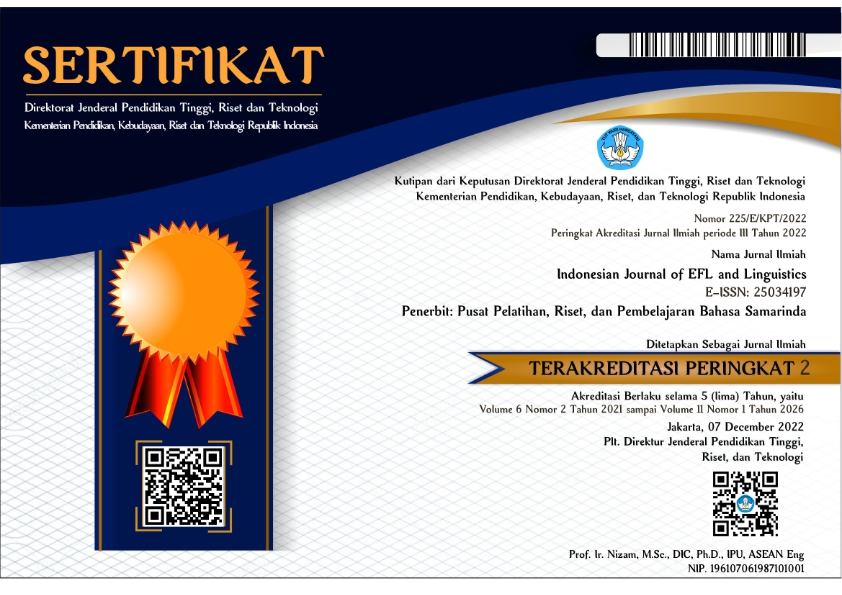Gender Representation in Merdeka Curriculum ELT Textbooks: A Corpus-assisted Study
Abstract
Gender representation in English textbooks has been an issue for a long period of time; it is important to monitor and assess the evolution of English textbooks regularly. This research examined how gender representation is presented in Merdeka curriculum-mandated English textbooks since there are gender imbalances and gender misconceptions in previous mandated English textbooks. Gender-related references used in the textbooks are analyzed using the Corpus tool and then measured to see how each gender is represented. Textbook analysis is important since they deliver values and could impact student’s perception of gender. This research intended to examine gender-related references and characteristics, therefore, corpus tools such as KWIC, plot, cluster, word, and collocate are used. This research found five categories of gender-related references in these textbooks: famous names, fictional names, ordinary names, generic nouns, and pronouns. Moreover, it is found that the Merdeka curriculum English textbooks did not present equal gender representation where male references are underrepresented and portrayed to only possess two emotions, happy and sad. Yet, female references dominated the presentation and portrayed as independent individuals who experienced lots of emotions such as furious, falling in love, ashamed, and other emotional attributes. Hence, the imbalance representation in textbooks should be revisited and should be based on more various natures of human emotions and roles.
References
Anjarwati, D. (2020). Gender Representation In The English Textbook (A Content Analysis of Pathway to English for Tenth Grade Senior High School Published by Erlangga). www.iainpurwokerto.ac.id
Aspers, P., & Corte, U. (2019). What is Qualitative in Qualitative Research. Qualitative Sociology, 42(2), 139–160. https://doi.org/10.1007/s11133-019-9413-7
Bachore, M. M. (2022). Analysis of Gender Representation in English Language Learning Materials: The Case of Grade Ten Textbook in Ethiopia. Journal of Curriculum and Teaching, 11(5), 175–185. https://doi.org/10.5430/jct.v11n5p175
Barton, A., & Sakwa, L. N. (2012). The representation of gender in English textbooks in Uganda. Pedagogy, Culture and Society, 20(2), 173–190. https://doi.org/10.1080/14681366.2012.669394
Bennett, G. R. (2010). An IntroductIon to corpus LInguIstIcs Part 1 Using Corpora in the Language Learning Classroom: Corpus Linguistics for Teachers. http://www.press.umich.edu/titleDetailDesc.do?id=371534
Bernat, E. (2015). Exploring the gender effect on EFL learners’ beliefs about language learning. http://www.newcastle.edu.au/group/ajedp/
Brugeilles, C., & Cromer, S. (2009). Analysing gender representations in school textbooks. UMR CEPED.
Bujupaj, G., & Gashi-Berisha, V. (2020). Gender representation in EFL course books explored through a corpus-based study: A case study. Science for Education Today, 10(6), 238–251. https://doi.org/10.15293/2658-6762.2006.13
Dharma, E., Betty Sihombing STIE Sultan Agung, H., & Sultan Agung, S. (2020). Merdeka belajar: kajian literatur.
Eriksson, E. (2022). Male-biased language: a diachronic corpus study of neutralization strategy in gender-based linguistic reforms.
Gabrielatos, C. (2014). Corpus Approaches to Discourse Studies: The basics Learner language View project Corpora and Language Learning/Teaching View project. https://doi.org/10.13140/2.1.2410.3683
Garton, S., & Graves, K. (2014). International Perspectives on Materials in ELT (S. Garton & K. Richards, Eds.). Palgrave Macmillan
Habib, F. A., Putra, B. A. W., & Setyono, B. (2020). 21602-157-47362-1-10-20201226. Jurnal EDUKASI, VII(3), 22–27.
Harwood, Nigel. (2010). English language teaching materials : theory and practice. Cambridge University Press.
Jannati, S. (2015). Gender Representation in EFL Textbooks: A Case of ILI Pre-intermediate Series. In Journal of Applied Linguistics and Language Research (Vol. 2, Issue 3).
Lee, J. F. K. (2014). Gender representation in Hong Kong primary school ELT textbooks - a comparative study. Gender and Education, 26(4), 356–376. https://doi.org/10.1080/09540253.2014.916400
Lestariyana, R. P. D., & Nurkamto, J. (2022). International Textbooks Analysis Used for EFL Students: A Critical Content Analysis of Multicultural from Kachru’s Models. Journal of Innovation in Educational and Cultural Research, 3(2), 248–256. https://doi.org/10.46843/jiecr.v3i2.103
Lestariyana, R. P. D., Widodo, H. P., & Sulistiyo, U. (2020). Female Representation in Government-Mandated English Language Textbooks Used in Indonesian Junior High Schools. Sexuality and Culture, 24(4), 1150–1166. https://doi.org/10.1007/s12119-020-09752-2
McEnery, T., & Wilson, A. (1996). Corpus linguistics. Edinburgh University Press.
Mustapha, A. S. (2012). Dynamics of gender representations in learning materials. Multidisciplinary Journal of Gender Studies, 1(3), 243–270. https://doi.org/10.4471/generos.2012.12
Paramitha, P. A., Sari, S. S. N., Syafitri, W., & Sundari, H. (2023). An Analysis of Gender Visibility in the EFL Textbook for Grade 7 In Indonesia. Prosiding Konferensi Berbahasa Indonesia Universitas Indraprasta PGRI, 211–216. https://doi.org/10.30998/kibar.27-10-2022.6315
Rohmawati, S., & Putra, K. A. (2022). Occupational Gender Stereotypes in Indonesian Secondary School English Language Textbooks. VELES Voices of English Language Education Society, 6(1), 160–175. https://doi.org/10.29408/veles.v6i1.5334
Samadikhah, M., & Shahrokhi, M. (2015). A critical discourse analysis of ELT materials in gender representation: A comparison of summit and Top Notch. English Language Teaching, 8(1), 121–133. https://doi.org/10.5539/elt.v8n1p121
Sánchez Aguilar, J. (2021). Gender Representation in EFL Textbooks in Basic Education in Mexico 1. In MEXTESOL Journal (Vol. 45, Issue 1).
Shallaita, B. A., Nawawi, N., & Amin, M. (2021). Analysis of English Language Teaching Materials on Gender Representation. International Journal of Multicultural and Multireligious Understanding, 8(2), 419. https://doi.org/10.18415/ijmmu.v8i2.2423
Sulaimani, A. (2017). Gender Representation in EFL Textbooks in Saudi Arabia: A Fair Deal? English Language Teaching, 10(6), 44. https://doi.org/10.5539/elt.v10n6p44
Suwarno, Triyono, S., Ashadi, & Sahayu, W. (2021). Gender Construction in the Indonesian Government-Distributed English Textbook: Combining Critical Discourse Analysis and Corpus Linguistics. Sexuality and Culture, 25(6), 2158–2175. https://doi.org/10.1007/s12119-021-09870-5
Tyarakanita, A., Drajati, N. A., Rochsantiningsih, D., & Nurkamto, J. (2021). The Representation of Gender Stereotypes in Indonesian English Language Textbooks. Sexuality and Culture, 25(3), 1140–1157. https://doi.org/10.1007/s12119-021-09813-0
Ullah, H., & Skelton, C. (2013). Gender representation in the public sector schools textbooks of Pakistan. Educational Studies, 39(2), 183–194. https://doi.org/10.1080/03055698.2012.702892
Wijayanti, F., Miqawati, A. H., Huda, I., & Mujib, A. (2022). Revealing Gender Bias on ELT Textbook: A Critical Discourse Analysis.
Winnie, C. (2013). Corpus-Based Linguistic Approaches to Critical Discourse Analysis. https://doi.org/10.1002/9781405198431.wbea10262
Yu Jin, N., Ling Vivian Yee, C., Tong Chong, S., & Ariff bin Ahmad Tarmizi, M. (2013). An Analysis on Gender-based Language and Illustrations in Malaysian Secondary Schools’ English Language and Literature Textbooks Community Based Disaster Management for Flood Prone Area View project. In Article in International Journal of Humanities and Social Science. www.ijhssnet.com
Copyright (c) 2023 Indonesian Journal of EFL and Linguistics

This work is licensed under a Creative Commons Attribution-NonCommercial-ShareAlike 4.0 International License.




